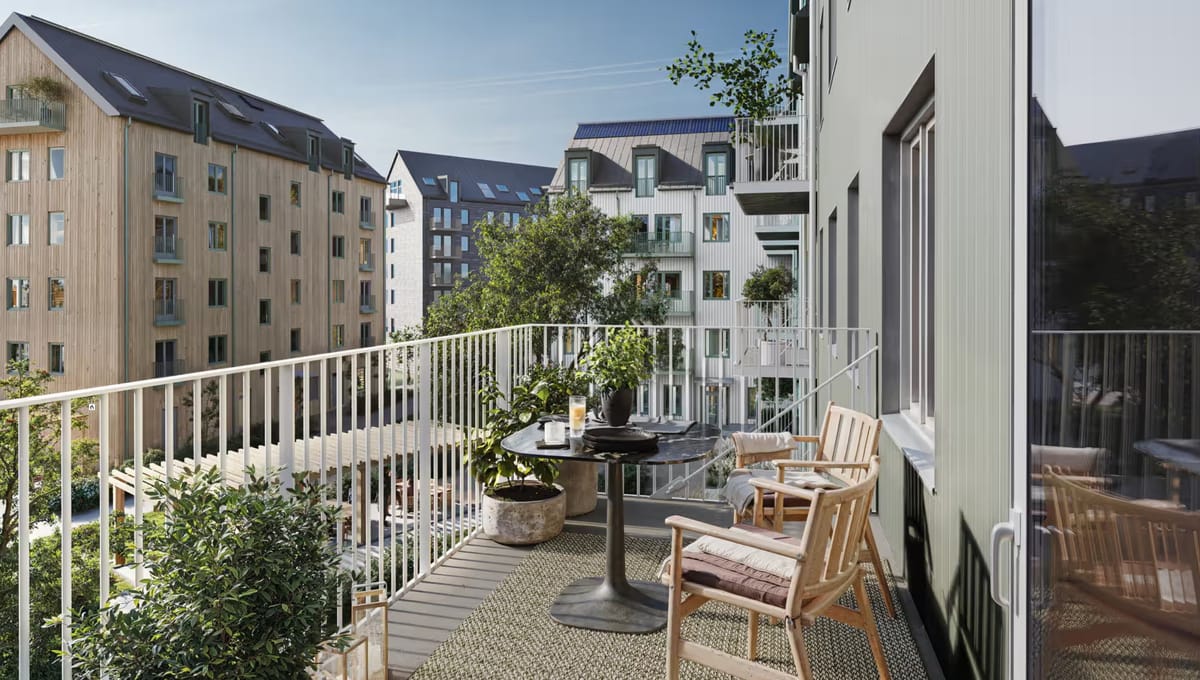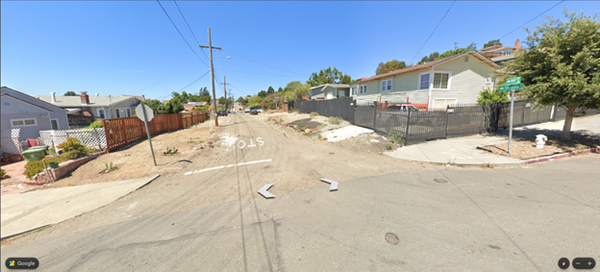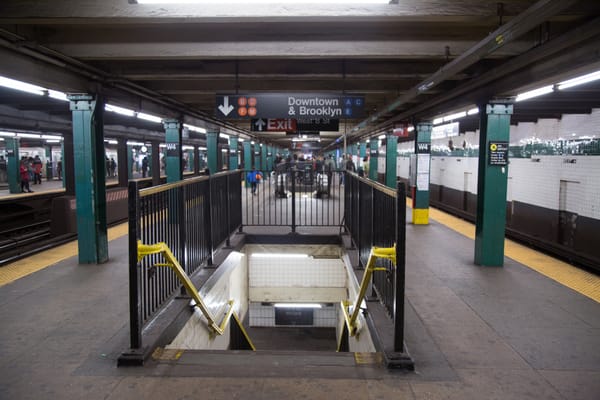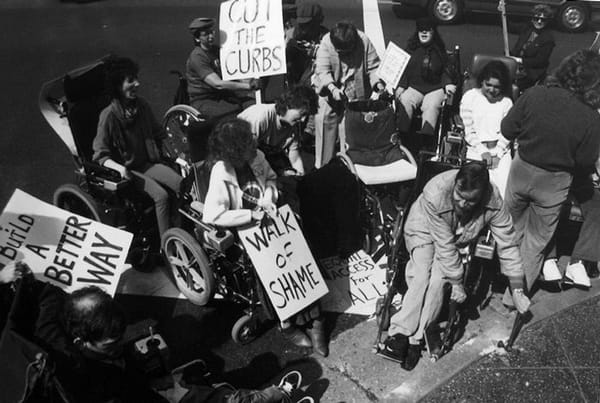4/28/25: Austerity, Inhumanity, and Timber 'hoods

Alex's note: I think it's important to be frank about the moment we are facing, so this issue will be more in line with my post from a couple weeks ago – "Trump 2.0 is a Disability Catastrophe (and it's Bad for Urbanism, too)" – that last week's "Let's start with the good this time." But I will end on a good note, albeit from Europe. (There are also positive domestic stories in the links at the end)
Austerity and illegally-canceled contracts are rearing their ugly heads, and this week reports have been coming out about disability nonprofits halting some programs due to lack of funds. A couple legal advocacy nonprofits – Disability Rights New Jersey (DRNJ) and Disability Rights Arkansas (DRA) – are temporarily pausing operations and refusing almost all new clients, respectively, because of an abrupt and likely illegal withholding of already-committed federal funds. DRA didn’t list its funding shortfall in a Facebook post, but DRNJ “has received only $1.6 million of the $3.1 million it needs this year to represent disabled people, including those in group homes and in prisons.”
This legal representation is critical for many disabled folks to secure and keep housing, among other human rights. Without it, they may face homelessness or move from living independently to living in a nursing home. But for now, these organizations and the people they serve are facing uncertainty at best.
Meanwhile, states that began using Medicaid funding in new and innovative ways under Biden are likely to get those programs’ approval rescinded in the next few years. For example, Cal Matters reports that California received a federal waiver to spend some Medicaid funds on housing and “medically tailored meals,” plus substance use and behavioral health support – with the idea that people that are properly fed, housed, and supported would have reduced healthcare costs and thus save Medi-Cal money (plus, you know, have more dignified lives). The alternative looks something like this:
For example, California’s street medicine doctors who take care of people who are homeless say that their patients often cycle in and out of the emergency room — the most expensive point of service in the health care system. They have no place to recover from medical procedures, no address to deliver medications, and the constant exposure to the elements takes years off of their lives, doctors say.
Waivers appear safe through the end of their prior approval timeline. The waiver for California’s largest at-risk program, called CalAIM, expires at the end of 2026, and “another similar waiver that supports California’s efforts to improve behavioral health care expires in 2029,” according to Cal Matters. Other states with similar programs also seem stable for the next year or four. However, every sign from the Trump administration points to non-renewal, with all its consequences for Medicaid recipients in need of stability and support.
On the immigration detention front, immigrants with disabilities scooped up by ICE are facing a whole set of nightmares in America’s overcrowded detention facilities. The Guardian highlights the experience of double amputee Rodney Taylor, who came to the US as a small child and has lived here for four decades. Taylor was scooped up on January 15 (so, under Biden) despite a green card pending, ostensibly over a conviction from his teenage years that he was pardoned for 15 years ago.
The lack of proper housing and disability-related supports while in ICE custody has led to complications including hip pain, a chronically swollen thumb, and “blisters on the stumps where his two legs were amputated when he was a toddler.” He’s missed meals and showers and is now facing shrinking protections because of the Trump administration:
But when the current administration closed the office for civil rights and civil liberties (CRCL) and the office of the immigration detention ombudsman (Oido) last month, detainees such as Taylor were left with less protection than ever – at a time when nearly 48,000 detainees are locked up nationwide, the highest number since October 2019.
“It’s all happening in the dark,” said Sarah Owings, Taylor’s attorney, speaking of conditions facing her client and others like him.
Taylor isn’t the only person with a disability being detained and losing access to healthcare, humane accommodations, and human rights protections – and of course, able-bodied people deserve these things too. But their absence will have major consequences. “Ultimately, I’m worried people will die, or suffer irreparable harm,” says Michelle Brané, ombudsman at the Oido until it was shut down, “and dying shouldn’t be the point at which we start caring.”
Republicans in Congress are looking at how to implement $880 billion in cuts to Medicaid over the next decade and may have landed on a strategy. According to ACAsignups.net, it seems like they're largely taking aim at Medicaid expansion and will attack it by changing the math on the Federal Medical Assistance Percentage (FMAP), which is the percentage of healthcare costs covered by the federal government. A January explainer from the same site states that:
For non-ACA Medicaid, the federal government pays between 50 - 83% of the cost depending on the state/territory (this is known as the Federal Medical Assistance Percentage, or FMAP). For the ~21 million people enrolled in Medicaid via the ACA [i.e. "medicaid expansion"], the federal gov't picks up 90% of the cost.
By reducing the FMAP for ACA Medicaid from 90% down to the state/territory’s non-ACA rate, Republicans are banking that states will simply ditch Medicaid expansion, and the 10 holdout states will never pursue it. 12 states have trigger laws where a reset FMAP will kill their ACA Medicaid, and even enthusiastic ACA Medicaid states may be unable to cover the extra cost. “Put another way,” says ACAsignups, “dropping the ACA expansion matching rate below 90% would mean kicking a minimum of 3.7 million and likely all 21 million low-income Americans off their healthcare coverage.” Republicans may also pursue a lower FMAP floor (below 50%) for conventional Medicaid, which would create huge financial burdens for the 10 states that have a 50% FMAP rate (“nine of which are blue,” ACAsignups notes: CA, CO, CT, MD, MA, NH, NJ, NY & WA).
Per a 2019 study, 24.3% of Medicaid-eligible adults (i.e., adults earning up to 138% of poverty, the Medicaid expansion cut off) had at least one disability. The study concluded that “Medicaid expansion appeared to be associated with lower uninsurance rates and higher Medicaid and private insurance coverage for persons with a disability.” Able-bodied people actually had bigger insurance coverage gains from ACA expansion – 4.6% versus 2.6% for disabled folks – but disabled people also have more acute healthcare needs and related benefits from insurance coverage. Either way, ripping away healthcare coverage from large numbers of able-bodied and disabled folks in the 40 expansion states is unconscionable, and is only being done to shower more wealth on the rich. (Some Republicans are getting cold-ish feet about Medicaid cuts, so it's not too late to hound your GOP representative).
Federal cuts aren’t the only dangers, as state governments with budget deficits are targeting disability-related programs for cuts. For example, New Jersey Gov. Phil Murphy’s proposed budget “includes $4 million in cuts to grants handed out annually by the state’s Division of Developmental Disabilities,” according to reporting by NorthJersey.com. The cuts touch programs such as Community Living Education, Donated Dental Services, and a Community Health Law Project that helps clients “secure housing, disability benefits, home care, insurance coverage and protection from abuse.” The state’s Centers for Independent Living are also facing $3 million in cuts, which “would amount to a 45% reduction in the centers’ $6.7 million operating budget.” Advocates are fighting for a better final budget and hope they can convince lawmakers this $4 million cut isn’t worth it.
In good news: wooden urbanism in Sweden
A well-designed urban environment will be good for a community’s physical and mental health, whether that’s through encouraging active transportation or providing third spaces that spark new friendships and community support. A new construction effort in South Stockholm is out to prove that a 25-hectare community made of wood can be good for both the environment and community health across its lifespan. The project is being built with a mix of glulam (glued laminated timber) and cross-laminated timber (CLT), which offer several construction benefits compared to concrete. The first is environmental: “[j]ust by choosing timber as the structural material,” The Guardian notes, “the company has said it reduces its climate impact by about 40%.” The second is the elimination of concrete and silica dust, with health benefits for construction crews. Third is speed: Atrium Ljungberg, the project developer, claims that it can build double the square footage per week by using timber over concrete.
Once the project is complete, residents of the completed Sickla neighborhood may find themselves more at peace. According to Oskar Norelius, one of the architects that worked on the project, “Wood regulates indoor humidity, creating a naturally comfortable climate throughout the year. Beyond that, studies show that visible timber has psychological benefits – it reduces stress, helps children concentrate better, and even supports faster recovery in patients. These effects carry over into offices and homes too.” In order to get the full benefits, Atrium Ljungberg is making a conscious effort to have copious visible timber inside and outside the buildings. They’re even keeping some older-growth trees at the expense of fresh landscaping.
The tangible environmental and construction benefits of timber mean we are bound to see more wooden buildings, especially in countries with a proactive mentality like Sweden. Our collective health will be better off for it.
In other news:
Senior housing is so scarce that many older adults are buying before they even need it – MarketWatch
Wales and north of England face disability cuts ‘double whammy’ – The Guardian
A new program trains college students for jobs helping homeless Californians. Can it survive? – Cal Matters
Democrats Launch Inquiry Into Dismantling of Administration for Community Living – Mother Jones
Iowa disability programs brace for potential cuts after budget leak – WHO 13
Trump administration kills landmark pollution settlement in majority-Black county – The Guardian
Former US social security head predicts ‘interruption of benefits’ amid Doge cuts – The Guardian
$40 Million Cut Threatens SCI Recovery Research – New Mobility
Abundance meets resistance: Are Democrats finally ready to go all in on building housing? – Cal Matters
Why 3D printing could make housing cheaper and more sustainable – ABC news
Upgraded Airplane Wheelchair-Seating Solution Unveiled – New Mobility
Housing Accommodations, Discrimination, & Action – Pushing Limits (KPFA Radio)
Montana’s Housing Miracle Strikes Twice – Sightline Institute
Trump’s transportation officials buck a long-held practice of using ‘road diets’ to slow speeders – AP
Guide to the National YIMBY Movement: Base-Building Organizations – Jeremy's Quarterly
Atlanta council approves redevelopment plan for Amsterdam Walk – The Atlanta Journal-Constitution




